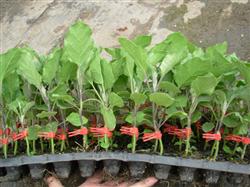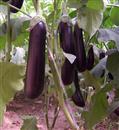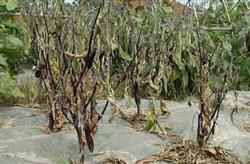Technology of Tomato grafting eggplant

With the development of facility agriculture, eggplant can be planted year after year, so soil-borne diseases such as eggplant Verticillium wilt have become the main obstacles affecting eggplant production. We used tomato (Maofan 802) as rootstock to graft eggplant, which not only effectively prevented eggplant Verticillium wilt and bacterial wilt, but also had tall and neat plants, good fruit quality and high yield. For eggplant grafting, we mainly use two methods: split grafting and leaning grafting. First, split grafting: generally, grafting is best when rootstocks and scions have 5-6 true leaves. Cut flat with a blade at the height of 3 cm of the rootstock, retain the lower 2-3 true leaves, remove the rest of the leaves, then use the blade to make a longitudinal cut 0.8-1.2 cm deep in the middle of the stem, pull out the grafted seedlings, leave 2-3 leaves at the top, cut them transversely, and cut them into a wedge, which is the same size as the cut of the rootstock, generally 0.7-1.1 cm, and then put the scion into the rootstock to make the graft consistent. When it is fixed with a grafting clip, the grafting is completed. It survived after about 10 days, with a survival rate of 90%. After the interface is completely healed, the clamp is removed and can be implanted in about 30 days. Second, leaning grafting: when the rootstock and scion grow to 2-3 true leaves. Cut obliquely between the first and second true leaves, cut the rootstock downward, cut the scion upward, cut about 0.5 cm, and fix the grafting clip. Third, grafting points for attention: first of all, the blades and clips used for grafting should be washed and disinfected, and the seedlings should be carefully taken and placed to keep them clean, do not touch the soil and do not wilt. Secondly, the grafting action is rapid, accurate and successful. Open-air grafting should be carried out after 4 o'clock in the afternoon in cloudy or sunny days, which can return seedlings quickly and have a high survival rate.
- Prev

Key points of eggplant cultivation in Crown King
The characteristics of Guanwang No. 1: medium maturity, strong growth potential, plant height of about 75 cm, good plant upright. Heat resistance, strong disease resistance, wide adaptability, strong fruiting power, fruit length about 40cm, rough 2.5cm, peel purple bright, smooth thin soft, white flesh, good quality. Cultivation points: 1, local climatic conditions and.
- Next

The technique of controlling eggplant wilt by prescribing the right medicine to the case
The main causes of eggplant wilting are blight, Sclerotinia sclerotiorum, stem rot, bacterial wilt, Verticillium wilt, root-knot nematode, fertilizer damage and so on. The specific diagnosis is as follows: 1. Look at the field distribution. When fertilizer damage occurs, it will wilt at noon on a sunny day, return to normal in the evening, and seriously cause plant death. And the other diseases mentioned above.
Related
- Where is it suitable to grow horseradish in China? it is expected to see the middle altitude horseradish in Alishan.
- How to prevent tomato virus disease reasonably? (Control methods included)
- Many people like to plant towel gourd on the balcony. What are the main points of this method and management?
- What crops can chili peppers be mixed with?
- Fertilization techniques and matters needing attention in Tomato
- What are the grafting techniques for peach seedlings in spring?
- Harm and control methods of root swelling disease of Chinese cabbage
- What are the pests of sweet potatoes? How to prevent and cure it?
- Symptoms, causes and Control methods of navel Rot in Tomato
- The cause of "Cucumber rotten bibcock" in Farmers' planting Cucumber and its Control Plan

